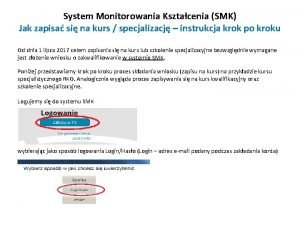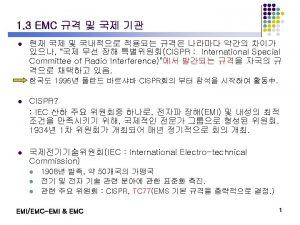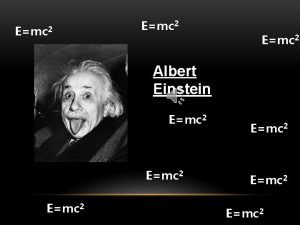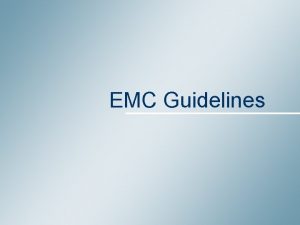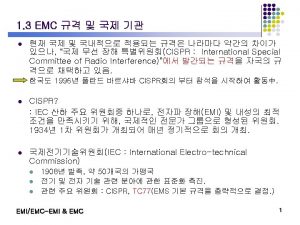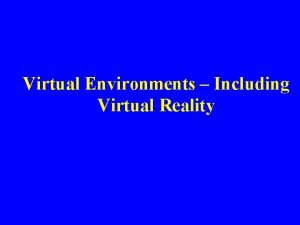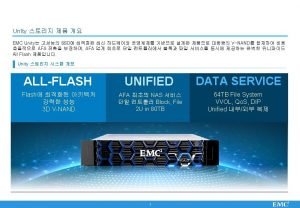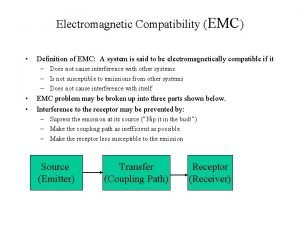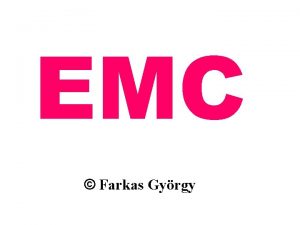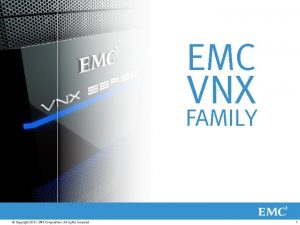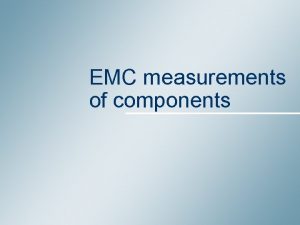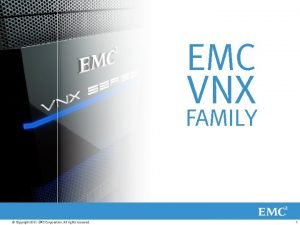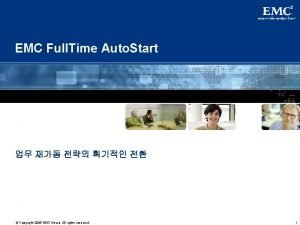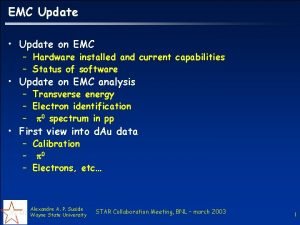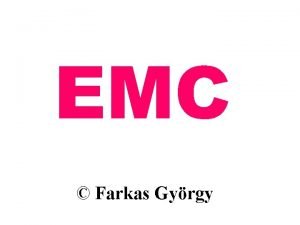EMC Europe 2010 Wroclaw Virtual Testing Area for


































- Slides: 34

EMC Europe 2010, Wroclaw “Virtual Testing Area” for Solving EMC Problems of Spatially Distributed Radiosystems based on Automated Double-Frequency Test System Vladimir Mordachev, Eugene Sinkevich Electromagnetic Compatibility R&D Laboratory, Belarusian State University of Informatics and Radioelectronics, Minsk, Belarus September 2010

Introduction 1. Automated Double-Frequency Test System (ADFTS) is a powerful hardware & software tool for detection and characterization of receiver interference responses 2. Adding some software to ADFTS hardware makes it possible to implement a new function: “Virtual Testing Area” (VTA) 3. Additional software needed to implement VTA: A. Geographical Information System (GIS) B. Radio-wave propagation simulator (RWP) C. Nonlinear simulator of the receiver under test (DNA) September 2010

Contents 1. Automated Double-Frequency Test System (ADFTS): essentials and capabilities 2. Virtual Testing Area (VTA): A. Main ideas and stages B. Software components: GIS, RWP, DNA C. Advantages D. Application September 2010

Automated Double-Frequency Test System (ADFTS) The main idea: • Receiver is fed by the sum of two frequency-sweeping signals with constant levels • Speed of sweeping is different (as in television): f 1 sweeps slowly and f 2 sweeps fast • The response at the receiver output is plotted as a function of the input frequencies f 1 and f 2 September 2010

Double-Frequency Characteristic 3 D Plot September 2010

Double-Frequency Characteristic Color Map Plot, which is called as “Double. Frequency Diagram” September 2010

Double-Frequency Diagram Special case: 2 colors Black means that output power is above threshold September 2010

ADFTS: Measurement Stages 1. Detection of interference responses 2. Recognition (interpretation) of interference responses 3. Measurement of response parameters September 2010

Recognition of responses Double. Frequency Diagram may be complicated: September 2010

Methods of response recognition 1. Marker Line 2. Simultaneous measurement of local oscillator frequencies for the receiver under test 3. Use of typical portraits (groups of response images on Double-Frequency Diagram) September 2010

1 st-order node It is the most common node since it contains images formed by the main receive channel (lines 1 and 2). This node is formed by intermodulation, receive channel and spurious response images of the types presented in table September 2010

2 nd-order node This node is formed with the contribution of the local oscillator signal second harmonic and contains intermodulation and spurious response path images of the types presented in table September 2010

3 rd-order node This node is formed with the contribution of the local oscillator signal third harmonic and contains intermodulation and spurious response path images of the types presented in table September 2010

Even-order IM A typical group of images formed by even order intermodulation due to direct passage of test signals nonlinear conversion products to the intermediate frequency path. This figure shows intermodulation and receive path images of the types presented in table September 2010

Measurement of response parameters At this stage, the standardized characteristics of the recognized responses are measured: 1. Desired Response Selectivity 2. Spurious Response Selectivity 3. Wide-Band Selectivity 4. Desensitization Selectivity 5. Cross-Modulation Selectivity 6. Intermodulation Selectivity September 2010

ADFTS of the last generation September 2010

ADFTS configured for testing by field September 2010

Testing Area: Problem Description • Usually, experimental checking of EMC is needed to turn a new system into operation • For complicated systems and complexes, experimental check of EMC needs trial operation or ground testing, which is very expensive and takes a lot of time, for example: ü Trial operation of GSM-1800 and UMTS in regions of intensive use of the aircraft navigation systems, military radars, and radio-relay systems ü Trial operation of DVB-T together with aircraft navigation systems, military radars, and mobile satellite systems • Precise simulation tool is needed to decrease the cost and time of EMC analysis and design September 2010

Simulation of Testing Area: Situation to consider 1. Spatially-distributed transmitters (potential interferers) 2. A receiver that may be influenced (potential victim) September 2010

Virtual Testing Area: Principles 1. Number of transmitters creating interference for the receiver is usually much smaller than the total number of transmitters • all the other transmitters may be neglected in receiver simulation 2. That is why the victim receiver can be simulated physically (i. e. , in hardware) 3. ADFTS hardware may be used to simulate the interfering signals at the receiver input 4. A site-specific propagation simulator is used to compute the levels of transmitter signals at the receiver input 5. A mathematical simulator of the receiver is used to recognize the interfering transmitters September 2010

Virtual Testing Area: Stages 1. Generation of electromagnetic environment model 2. Selection of the most dangerous interferers 3. Physical modeling of the receiver under test September 2010

Virtual Testing Area: Stage 1 1. Generation of electromagnetic environment model A. Define a variant (scenario) of area allocation of radiosystems’ transmitters – potential interference sources B. Calculate electromagnetic fields from these transmitters at the point of the receiver-under-test antenna location (propagation models based on ITU-R Recommendations are used) C. Take into account the antenna of the receiver under test (compute the levels of the interfering signals at the antenna input of the receiver) 2. Selection of the most dangerous interferers 3. Physical modeling of the receiver under test September 2010

Virtual Testing Area: Stage 2 1. Generation of electromagnetic environment model 2. Selection of the most dangerous interferers A. Find, recognize, and measure the parameters of the receiver interference responses by the use of Automated Double-Frequency Test System B. From that measurements, extract the nonlinear model of the receiver under test C. Using the extracted nonlinear model, simulate the receiver by feeding its antenna input with the electromagnetic environment model computed at stage 1 D. If an interference appears at the receiver model output, find the transmitters that create the interference 3. Physical modeling of the receiver under test September 2010

Virtual Testing Area: Stage 3 1. Generation of electromagnetic environment model 2. Selection of the most dangerous interferers 3. Physical modeling of the receiver under test A. Set the parameters (frequency, level, modulation) of ADFTS measurement generators in order to simulate the interfering transmitters found at stage 2 B. Feed the receiver under test with the sum of the signals from the ADFTS measurement generators C. Check the existence and level of interference at the receiver output September 2010

Virtual Testing Area: Additional Software Components 1. Geographical Information System (GIS) A. Map. Info B. Panorama C. Our own platform (obsolete) 2. Radio-wave propagation simulator (RWP) ü site-specific algorithms based on ITU-R Rec. (452, 1546, 530, 833, etc. ) are used 3. Nonlinear simulator of the receiver under test ü Discrete Nonlinear Analysis (DNA) technology is used September 2010

Main idea of DNA: to model nonlinearities in the time domain • Frequency-domain formula (for one component) • Time-domain formula (for one sample) September 2010

Number of IM products grows rapidly with increasing environment complexity and degree of nonlinearity September 2010

Traditional technique of nonlinear EMC analysis can not solve complicated problems • DNA can address the last case on PC in 25 sec! September 2010

DNA capabilities (1) • DNA is very fast and computationally invariant to radio environment severity. DNA is able to model the radio reception in an extremely severe (up to 100 000 of modulated signals) electromagnetic environment • DNA is able to analyze the aggregate influence of all major types of nonlinear effects (intermodulation, desensitization, cross-modulation, reciprocal mixing, AM-AM and AM-PM conversion, spurious responses) on the system performance • DNA is able to consider multi-signal and high-order nonlinear effects (due to the use of high-order nonlinearity models – up to 25 -th order) September 2010

DNA capabilities (2) • DNA is intended for simulation in a wide frequency range (from zero to 10 times of carrier frequency, and wider) • DNA supports the simulation in a wide dynamic range of amplitudes (up to 300 d. B) • DNA is supplied with the efficient procedure for search of nonlinear interference (e. g. intermodulation) sources • The advantages of DNA over traditional techniques increase with increasing the electromagnetic environment severity September 2010

Virtual Testing Area: Advantages 1. Low cost and high speed of EMC analysis and design (because the real-world testing area is simulated) 2. High speed of EMC analysis results in ability to consider many scenarios of allocation for the transmitters and for the receiver on the testing area 3. Low errors of testing area simulation (because of physical modeling of the receiver under test) • Error in the radiowave propagation models is the main error of the Virtual Testing Area September 2010

Virtual Testing Area: Application • EMC analysis and design for civil and military objects of Belarus • Years of experience in using Virtual Testing Area September 2010

Virtual Testing Area: Application Tricks and Peculiarities • Several signals may be modeled by one measurement generator ü For example, the whole GSM-900 band was modeled as one aggregate signal when considering interference to aircraft navigation systems • Special measurements may be arranged to check the radiowave propagation models ü If several systems from the complex are already in operation, their signals at expected location points of the other systems may be measured September 2010

Conclusion 1. Virtual Testing Area increases the details and speed of EMC analysis between spatially-distributed radio systems 2. Virtual Testing Area uses the hardware of the Automated Double-Frequency Test System (ADFTS) to perform physical modeling of the victim receiver 3. Virtual Testing Area includes additional software: A. Geographical Information System (GIS) B. Radio-wave propagation simulator (site-specific algorithms based on ITU-R Rec. are used) C. Nonlinear simulator of the receiver under test (Discrete Nonlinear Analysis technology is used) September 2010
 Eckp wroclaw
Eckp wroclaw Emc storage integrator
Emc storage integrator Twtas for emc testing
Twtas for emc testing Host bus adapter
Host bus adapter Has virtual functions and accessible non-virtual destructor
Has virtual functions and accessible non-virtual destructor Domain testing
Domain testing Kv charts in software testing
Kv charts in software testing Du path testing
Du path testing Positive negative testing
Positive negative testing Cs3250
Cs3250 What is globalization testing
What is globalization testing Functional testing vs unit testing
Functional testing vs unit testing Cause effect graphing technique
Cause effect graphing technique Control structure testing in software engineering
Control structure testing in software engineering Decision table testing in software testing
Decision table testing in software testing Decision table testing example
Decision table testing example Black box testing adalah
Black box testing adalah Behavioral testing adalah
Behavioral testing adalah Extended entry decision table
Extended entry decision table Rigorous testing in software testing
Rigorous testing in software testing Testing blindness in software testing
Testing blindness in software testing Component testing is a black box testing
Component testing is a black box testing Domain example
Domain example Formuö
Formuö Typiska novell drag
Typiska novell drag Tack för att ni lyssnade bild
Tack för att ni lyssnade bild Ekologiskt fotavtryck
Ekologiskt fotavtryck Varför kallas perioden 1918-1939 för mellankrigstiden
Varför kallas perioden 1918-1939 för mellankrigstiden En lathund för arbete med kontinuitetshantering
En lathund för arbete med kontinuitetshantering Underlag för särskild löneskatt på pensionskostnader
Underlag för särskild löneskatt på pensionskostnader Tidbok yrkesförare
Tidbok yrkesförare A gastrica
A gastrica Förklara densitet för barn
Förklara densitet för barn Datorkunskap för nybörjare
Datorkunskap för nybörjare Tack för att ni lyssnade bild
Tack för att ni lyssnade bild
